

Artículos
Heterocera fauna of the Calabrian black pine forest, Sila Massif (Italy) (Insecta: Lepidoptera)
Fauna de Heterocera del bosque de pino negro de Calabria, Macizo de Sila (Italia) (Insecta: Lepidoptera)
Heterocera fauna of the Calabrian black pine forest, Sila Massif (Italy) (Insecta: Lepidoptera)
SHILAP Revista de Lepidopterología, vol. 46, no. 183, 2018
Sociedad Hispano-Luso-Americana de Lepidopterología
Received: 01 March 2018
Accepted: 10 May 2018
Published: 30 September 2018
Abstract: In this paper we described the Heterocera fauna of the Calabrian black pine forest in the Sila Massif, southern Italy. We sampled 15 stands at 1270-1446 meters of altitude. One UV-Led light traps per stand was turned on once per month from May to November 2015 and from April to November 2016. We collected 18,827 individuals belonging to 367 species. Thaumetopoea pityocampa (Notodontidae) and Alcis repandata (Geometridae) were the most abundant species. Conifers are the main larval foodplant of 11 species and 4,984 individuals. Particularly interesting was the presence of Eupithecia indigata, discovered in Italy outside the Alps few years ago, abundant in pure Calabrian black pine stands. Also, the recently described Italian endemic Hylaea mediterranea was abundant, and together with E. indigata compose and unique species assemblage characterizing Lepidoptera fauna of the Calabrian black pine forests of the Sila Massif. During the spring, communities were dominated by Eupithecia indigata and Agrotis cinerea, during the summer Thaumetopoea pityocampa, Alcis repandata, Idaea deversaria, and Dendrolimus pini were dominant, and autumn communities were characterized by Pennithera firmata and Colostygia sericeata. We confirmed the presence of Acossus terebra, Dichagyris signifera, Acasis appensata, Mesotype didymata, Plusidia cheiranthi, Trichopteryx carpinata, and Lithophane socia. The relevant interest of this fauna was completed by the presence of several Italian endemic species: Hydriomena sanfilensis, Idaea mutilata, Itame messapiaria, Megalycinia serraria, Nychiodes ragusaria, and Xanthorhoe vidanoi.
Keywords: Insecta, Lepidoptera, biodiversity, Pinus laricio calabrica, Sila National Park, Calabria, Italy.
Resumen: Describimos en este trabajpo la fauna de Heterocera en el bosque del pino negro calabrés en el Macizo de Sila, sur de Italia. Muestreamos en 15 lugares entre los 1.270-1.446 metros de altitud. Una de las trampas de luz UV-led estuvo encendida una vez al mes, desde mayo a noviembre de 2015 y de abril a noviembre de 2016. Se recogieron 18.827 ejemplares que pertenecían a 367 especies. Thaumetopoea pityocampa (Notodontidae) y Alcis repandata (Geometridae) eran las especies más abundante. Las coníferas son la principal planta nutricia de 11 especies y 4.984 ejemplares. La presencia de Eupithecia indigata, descubierta en Italia fuera de los Alpes hace pocos años, es abundante y particularmente interesante en el bosque del pino negro calabrés. También, el endemismo italiano Hylaea mediterranea, recientemente descrito, era abundante y junto con la especie E. indigata compone un conjunto único característico de la fauna de Lepidoptera del pino negro calabrés del Macizo de Sila. Durante la primavera, las comunidades estaban dominadas por Eupithecia indigata y Agrotis cinerea, durante el verano Thaumetopoea pityocampa, Alcis repandata, Idaea deversaria y Dendrolimus pini y las comunidades de otoño fueron caracterizadas por Pennithera firmata y Colostygia sericeata. Confirmamos la presencia de Acossus terebra, Dichagyris signifera, Acasis appensata, Mesotype didymata, Plusidia cheiranthi, Trichopteryx carpinata y Lithophane socia. El interés relevante de esta fauna, concluye con la presencia de algunas especies endémicas italianas: Hydriomena sanfilensis, Idaea mutilata, Itame messapiaria, Megalycinia serraria, Nychiodes ragusaria y Xanthorhoe vidanoi.
Palabras clave: Insecta, Lepidoptera, biodiversidad, Pinus laricio calabrica, Parque Nacional de Sila, Calabria, Italia.
Introduction
The Sila Massif is a very peculiar mountainous area, located at the southern part of the Apennines (Italy). It is geologically a piece of Alps which has been migrated with Corsica and Sardinia from Provence across the Mediterranean Sea toward the current position. The geological substratum is mainly granitic, differing from the calcareous-karst of the rest of Apennines, promoting a pronounced surface hydrography. The richness of waters in this area, joined with the characteristics of rocks, confers a typical cold-humid climate. The acid substratum, the high soil permeability due to the sands derived from the meteoric alteration of granitic rocks, and the large surface of territory with an altitude higher than 1100 metres above the sea level, create climatic and environmental conditions favouring the presence of relict populations of plants and animals usually distributed at higher latitudes (BRANDMAYR et al., 2013). The Sila Massif is characterized by the forests of Calabrian black pine, Pinus laricio calabrica (Loudon) Cesca & Peruzzi, an endemic conifer subspecies which extends along the Italian regions of Calabria and Sicily (CESCA & PERUZZI, 2002). Calabrian black pine forests of the Sila Massif appear heterogeneous, interrupted by pastures, crops and beech forests, sometimes mixed with silver fir trees. During and after the Second World War, pine forests of the Sila Massif were intensively deforested causing a large soil erosion and altering the natural evolution of woodlands. A great part of pure pine forests, located between 900 and 1300 m asl, are reforestations carried out between the years 1950 and 1970 (IOVINO & MENGUZZATO, 2000; CIANCIO et al., 2005). Over time, Sila pine forests acquired a great conservation importance and most of the pine forests are nowadays within the Sila National Park (CIANCIO et al., 2010), which includes several Sites of Community Importance (SCI) (BRANDMAYR et al., 2013). Furthermore, this forest type is included among the (Sub-) Mediterranean pine forests with endemic black pines (Habitat Code 9530) (Habitat Directive 92/43/EEC).
Lepidopteran fauna of the Sila Massif was explored by several authors which highlighted the great interest of this mountainous area providing always surprises to lepidopterists. For example, the recently described Nothocasis rosariae Scalercio, Infusino & Hausmann, 2016 (Geometridae) has here its locus typicus (SCALERCIO et al., 2016). Among macrolepidoptera, one species is endemic of this massif, Itame messapiaria Sohn-Rethel, 1929 (Geometridae), a number of species has relict populations here, some of which reported in Italy with certitude only for the Alps and for Sila Massif and neighbouring areas, namely Brenthis ino (Rottemburg, 1775) (Nymphalidae), Acossus terebra ([Denis & Schiffermüller], 1775) (Cossidae), Eupithecia indigata ([Hübner, 1813]) (Geometridae), Dichagyris signifera ([Denis & Schiffermüller], 1775) (Noctuidae). Furthermore, Zygaena nevadensis Rambur, 1858 (Zygaenidae) and Eupithecia conterminata (Lienig, 1846) (Geometridae) are known with certitude in Italy only from the Sila Massif (EFETOV et al., 2011; INFUSINO & SCALERCIO, 2015). Although its great biogeographic importance, very few data concerning abundance and community composition of moths inhabiting the Sila Massif are available (SCALERCIO et al., 2008; INFUSINO et al., 2017a), and none of these is specifically devoted to the fauna of Calabrian black pine forests. This kind of data are of crucial importance for identifying modifications in the ecosystem due to land-use and climate changes.
The aim of this study was to improve the knowledge about moth fauna inhabiting Calabrian black pine forests, exploring mature forests, young reforestations, and non-forested habitats surrounded by a forest matrix. We reported the complete checklist of sampled moth species, with abundance and phenology data.
Material and methods
STUDY AREA
The massif is conventionally divided into three geographic zones, named Sila Greca, Sila Grande and Sila Piccola, from the North to the South. This study was carried out in the Sila Grande, largely covered by Calabrian black pine forests. Investigated forests are partly included in the Sila National Park and extend between 1270 and 1446 meters of altitude. We sampled 15 stands, grouped in 5 threes (SL_A1,2,3, SL_B1,2,3, SL_C1,2,3, SL_D1,2,3, SL_E1,2,3). Stands composing a threes were located in the same locality in order to reduce the bias due to uncontrolled environmental parameters. Furthermore, any threes are composed by one mature pine forest, one reforestation, and one open habitat surrounded by a forest matrix (Figure 1, Table I).
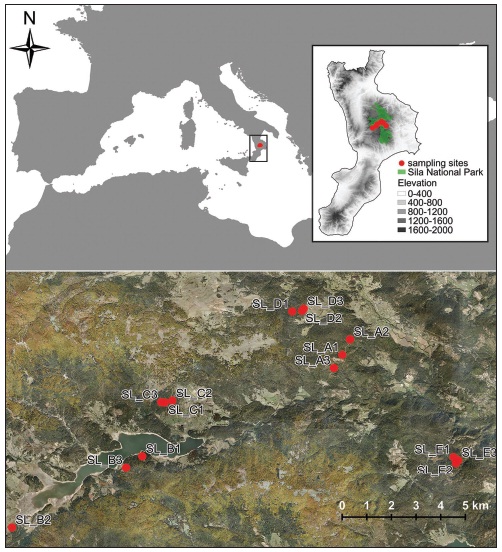
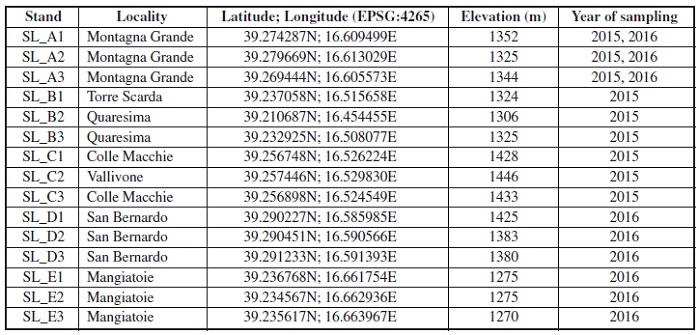
SAMPLING DESIGN
Moth sampling was carried out by using UV-Led light traps (further details in INFUSINO et al 2017b). One trap was positioned in each stand, activated one night per month during nights favorable to the moth activity (i.e. low wind intensity, no full moon interference, no or very low rainfall, temperatures near the average of the period). The sampling was carried out in two years, from May to November 2015 in the threes SL_A, SL_B and SL_C, and from April to November 2016 in SL_A, the only threes replicated for two years, SL_D and SL_E. In detail, 2015 sampling nights were 18-V, 15-VI, 17-VII, 18-VIII, 7-IX, 5-X, and 4-XI, and 2016 sampling nights were 12-IV, 11-V, 7-VI, 5-VII, 25-VII, 13-IX, 3-X, and 7-XI.
Collected specimens were identified according to the available literature and preserved in the collection of the Council for Agricultural Research and Economics, Research Centre for Forestry and Wood (CREA-FL), Rende (Cosenza), Italy. Most difficult species were dissected for a correct identification. Nomenclature follow the most recent version of Fauna Europaea (KARSHOLT & NIEUKERKEN, 2013). Species are listed in alphabetical order within any family.
Results
A total of 367 species and 18,827 individuals belonging to 13 families was collected. In the following faunistic list we reported for any species the number of individuals collected in each stand, the total abundance and the phenology indicated as the month of sampling.
Discussion
Most abundant species in Calabrian black pine forests were Thaumetopoea pityocampa (Notodontidae) (11.7%) and Alcis repandata (Geometridae) (10.5%). The first species, already known for its role as defoliator, usually lives in sub-nemoral habitats and has oligophagous larvae feeding on conifers, mainly Pinus spp., Larix spp., Picea spp., and Juniperus spp. (BERTACCINI et al., 1997). The second species usually prefers nemoral habitats and has polyphagous larvae mainly feeding on trees and shrubs (HELLMANN & PARENZAN, 2010). The 65% of individuals belonged to 23 species only, whilst the remaining 344 species, with less than the 1% of occurrence each, represented the 35.7% of total abundance (Figure 2).
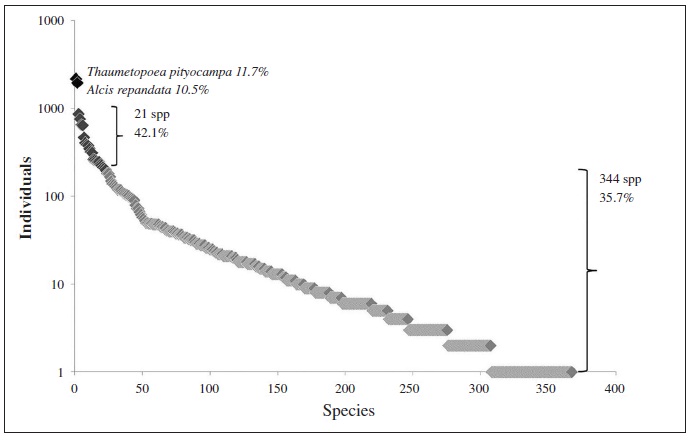
Conifers are the main larval foodplant of 11 species and 4,984 individuals, representing the 26.5% of the whole community (Table II). Particularly interesting was the abundance of Eupithecia indigata, a species only recently discovered in Italy outside the Alps in a mixed reforestation of broadleaves and conifers of the Catena Costiera mountains, Calabria (SCALERCIO, 2004, 2014). Successively, it was also found in a beech forest (SCALERCIO et al., 2008) and in a mixed forest (INFUSINO & SCALERCIO, 2015) of the Sila Massif, always with rare individuals. This species was particularly abundant in pure Calabrian black pine stands because larvae are oligophagous on conifers (MIRONOV, 2003). Also, the recently described Italian endemic Hylaea mediterranea, another species with larvae feeding on conifers, was abundant, and together with E. indigata contributed to compose and unique species assemblage univocally characterizing moth fauna of the Calabrian black pine forests of the Sila Massif.
Species feeding only on herbaceous plants composed the most richs (164 species), and abundant (5,594 individuals) portion of the community, representing about the 30% of the total abundance (Table II). Most of them are nemoral or sub-nemoral such as Epirrhoe galiata (n=655), E. alternata (n=232), Idaea deversaria (n=651), Scotopteryx luridata (n=259), Cerastis rubricosa (n=255), Charanyca ferruginea (n=215), and Pachetra sagittigera (n=472), whilst species preferring grasslands were less represented with only Agrotis cinerea (n=390) and Chiasmia clathrata (n=207) collected in a high number of individuals. Also, the abundance of Colostygia sericeata (n=200) should be underlined, as the taxonomic identity of southern Italy populations is still uncertain (HAUSMANN & VIIDALEPP, 2012).
During the spring, communities were dominated by Eupithecia indigata, particularly common within denser forest stands, whilst open habitats were characterized by Agrotis cinerea. Well represented were also Epirrhoe galiata, Pachetra sagittigera and Cerastis rubricosa. During the summer, several species attained high abundance values among which Thaumetopoea pityocampa, Alcis repandata, Idaea deversaria, and Dendrolimus pini were dominant. During the autumn most abundant species, were Pennithera firmata and Colostygia sericeata, accompanied by Larentia clavaria and Conistra torrida. Species characterizing the fauna of Calabrian black pine forests were generally monovoltine, as usually occur in mountain habitats, with the exception of Hylaeamediterranea on wings from May to July and from September to October. The endemic Itame messapiaria is likely monovoltine although it showed a prolonged flying period lasting from May to early September. Other bivoltine species, such as Aplocera plagiata, Charissa onustaria, Cosmorhoe ocellata, Gymnoscelis rufifasciata, Peribatodes rhomboidaria, and Pseudoterpna coronillaria, were widespread, occurring in southern Italy within several habitat types at different altitudes.
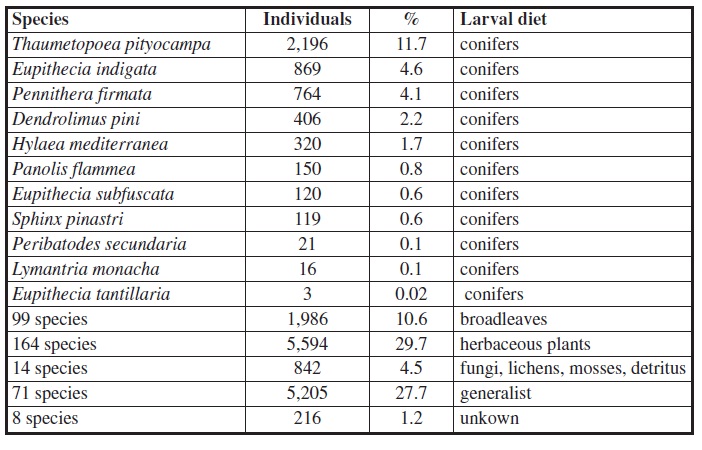
In this paper we confirmed the presence in the Sila Massif of several species of great biogeographic interest: Acossus terebra and Dichagyris signifera known in Italy with certitude outside the Alps only in the Sila Massif (PARENZAN, 1982; ZILLI, 2005); Acasis appensata, Mesotype didymata, and Plusidia cheiranthi known in southern Italy only in the Sila Massif (PARENZAN, 1979; INFUSINO et al., 2017c); Trichopteryx carpinata and Lithophanesocia only recently found in Calabria for the first time (INFUSINO et al., 2017c), but the latter erroneously identified as L. semibrunnea due to a mistake in a plate of BERIO (1985) used for the species identification. The relevant interest of the fauna of this forest type was completed by the presence of the following Italian endemic species: Hydriomena sanfilensis, Idaea mutilata, Itame messapiaria, Megalycinia serraria, Nychiodes ragusaria, and Xanthorhoe vidanoi.
Conclusions
Calabrian pine forests are differently managed depending on their location. Inside the boundaries of the Sila National Park, the pine forests are preserved for conservation purposes, outside the Park they are submitted to various timber harvest strategies. Several reforested hectares are only rarely managed and then prone to fires and damages due to severe climatic conditions (NICOLACI et al., 2014). We sampled moth communities within all these differently managed Calabrian black pine forests, that showed in all cases a very interesting and characteristic spectrum of species, rich of relicts and endemics. Furthermore, sampled communities are a faunistic unicum as host species the range of which is overlapped only in this forest type of the Calabria region. In addition, preliminary results showed that also the most abundant species trophically linked to conifers, Thaumetopoea pityocampa, has a population genetically different from those of the rest of the Apennines (TREMATERRA et al., 2017), confirming the long isolation history of this conifer forest composed by an endemic tree.
Aknowledgement
We thank Marco Infusino, Carlo Di Marco, Carlo De Donato, and Antonio Impieri (Italy) for helping in the field. The current investigation was funded as part of the Project “ALForLab” (PON03PE_00024_1) co-funded by the National Operational Programme for Research and Competitiveness (PON R&C) 2007-2013, through the European Regional Development Fund (ERDF) and national resource [Revolving Fund - Cohesion Action Plan (CAP) MIUR].
BIBLIOGRAPHY
BERIO, E., 1985.– Lepidoptera Noctuidae. I. Generalità Hadeninae Cuculliinae.– Fauna d’Italia, 22: 970 pp., 32 pls. Ed. Calderini, Bologna.
BERTACCINI, E., FIUMI, G. & PROVERA P., 1997.– Bombici e Sfingi d’Italia (Lepidoptera Heterocera), 2: 256 pp., 16 pls. Natura, Giuliano Russo Ed., Monterenzio, Bologna.
BRANDMAYR, P., GANGALE, C., MAZZEI, A., MINGOZZI, A., PIZZOLOTTO, R., URSO, S., SCALERCIO, S., TRIPEPI, S., ALOISE, G. & OUZUNOV, D., 2013.– L’approfondimento: la biodiversità animale e vegetale della Sila.– Sinergie rapporti di ricerca, 37: 71-93.
CESCA, G. & PERUZZI, L., 2002.– Pinus laricio Poir. and P. leucodermis Antoine: karyotype analysis in Calabrian populations (Southern Italy).– Caryologia, 55(1): 21-25.
CIANCIO, O., IOVINO, F., MENGUZZATO, G. & NICOLACI, A., 2005.– Analisi strutturale e modalità di gestione delle pinete di laricio in Sila.– L’Italia Forestale e Montana, 60(4): 521-539.
CIANCIO, O., IOVINO, F., MENGUZZATO, G., NICOLACI, A. & VELTRI, A., 2010.– Stand structure of a Calabrian pine old-growth forest: indications for forest management and landscape conservation.– Italian Journal of Forest and Mountain Environments, 65(5): 529-544.
EFETOV, K. A., TARMANN, G. M. & TREMEWAN, W. G., 2011.– Zygaena nevadensis Rambur, 1858 (Lepidoptera: Zygaenidae, Zygaeninae) newly recorded from the southern tip of the Penisola Appenninica (Apennine Peninsula), Italy.– Entomologist’s Gazette, 62: 123-129.
HAUSMANN A. & VIIDALEPP J., 2012.– Larentiinae I (Perizomini and Eupitheciini).– In A. HAUSMANN (ed.). The Geometrid Moths of Europe, 3: 743 pp., 25 pls. Apollo Books, Stenstrup.
HELLMANN, F. & PARENZAN, P., 2010.– I macrolepidotteri del Piemonte. Monografie XLVI: 1057 pp., Museo Regionale di Scienze Naturali, Torino.
INFUSINO, M. & SCALERCIO, S., 2015.– Eupithecia conterminata (Lienig, 1846) una specie silvicola alloctona nuova per la fauna italiana nel Parco Nazionale della Sila, area MAB UNESCO (Lepidoptera, Geometridae).– Bollettino della Società Entomologica Italiana, 147(2): 85-88.
INFUSINO, M., BREHM, G., DI MARCO, C. & SCALERCIO, S., 2017b.– Assessing the efficiency of UV LEDs as light sources for sampling the diversity of macro-moths (Lepidoptera).– European Journal of Entomology, 114: 25-33.
INFUSINO, M., LUZZI, G. & SCALERCIO, S., 2017a.– I macrolepidotteri notturni dell’Arboreto Sbanditi, Area MAB-UNESCO, Parco Nazionale della Sila (Calabria, Italia).– Memorie della Società entomologica italiana, 94(1-2):137-153.
INFUSINO, M., LUZZI, G. & SCALERCIO, S., 2017c.– New insights on Lepidoptera of Southern Italy with description of the male of Coenotephria antonii Hausmann 2011 (Lepidoptera).– Journal of Entomological and Acarological Research, 49:89-96.
IOVINO F. & MENGUZZATO G., 2000.– I rimboschimenti: storia e significato. Il caso della Calabria. Proceeding of the Seminar: Rimboschimenti e piantagioni nelle trasformazioni del paesaggio. Roma, 3 dicembre 1999. International Association of Enviromental Design.
KARSHOLT, O. & NIEUKERKEN, E. J. van, 2013.– Lepidoptera, Moths. Fauna Europaea version 2.6. Available from https://www.fauna-eu.org
MIRONOV, L., 2003.– Larentiinae II (Perizomini and Eupitheciini).– In A. HAUSMANN (ed.). The Geometrid Moths of Europe, 4: 464 pp., 7 pls. Apollo Books, Stenstrup.
NICOLACI, A., TRAVAGLINI, D., MENGUZZATO, G., NOCENTINI, S., VELTRI, A. & IOVINO, F., 2014.– Ecological and anthropogenic drivers of Calabrian pine (Pinus nigra J. F. Arn. ssp. laricio (Poiret) Maire) distribution in the Sila mountain range.– Forest-Biogeosciences and Forestry, 8(4): 497.
PARENZAN, P., 1979.– Contributi alla conoscenza della Lepidotterofauna dell’Italia Meridionale. V. Heterocera: Noctuidae, 15: 159-278 pp., 23 figs. Entomologica, Bari.
PARENZAN, P., 1982.– Bombyces e Sphinges (Lepid.-Heterocera) dell’Italia meridionale (addenda), 17: 103-125 pp. Entomologica, Bari.
SCALERCIO, S., 2004.– Caratterizzazione della comunità dei macrolepidotteri eteroceri fototropici della pinoabetina di Monte Cocuzzo (Calabria, Italia).– Proceedings of XIX Congresso nazionale italiano di Entomologia, Catania 10-15 giugno 2002, I: 237-242, 2 figs.
SCALERCIO, S., 2014.– Moth diversity of a reforested site at Monte Cocuzzo (Calabria, Southern Italy).– In A. ZILLI (ed.). Lepidoptera research in areas with high biodiversity potential in Italy, 1: 295-317. Natura Edizioni Scientifiche, Bologna.
SCALERCIO, S., INFUSINO, M. & HAUSMANN, A., 2016.– Nothocasis rosariae sp. n., a new sylvicolous, montane species from southern Europe (Lepidoptera: Geometridae, Larentiinae).– Zootaxa, 4161 (2): 177 192.
SCALERCIO, S., INFUSINO, M. & TUSCANO J., 2008.– I macrolepidotteri notturni della faggeta di Monte Curcio, Sila Grande (Calabria, Italia meridionale)-(Lepidoptera).– Quaderni della Stazione di Ecologia del Civico Museo di Storia Naturale di Ferrara, 18: 5-19, 2 figs.
TREMATERRA, P., SCALERCIO, S. & COLACCI, M., 2017.– Thaumetopoea hellenica sp. n. and Thaumetopoea mediterranea sp. n. new taxa from southern Europe (Lepidoptera Notodontidae Thaumetopoeinae).– Redia, 100: 3-10.
ZILLI, A., 2005.– Insecta Lepidoptera Noctuidae (Plusiinae, Noctuinae) (e Lasiocampidae, Arctiidae, Sphingidae).– In S. RUFFO & F. STOCH (eds.). Checklist e distribuzione della fauna italiana. 10.000 specie terrestri e delle acque interne.– Memorie del Museo Civico di Storia Naturale di Verona-2. Serie, Sezione Scienza della Vita, 16: 265-268.
Anexos
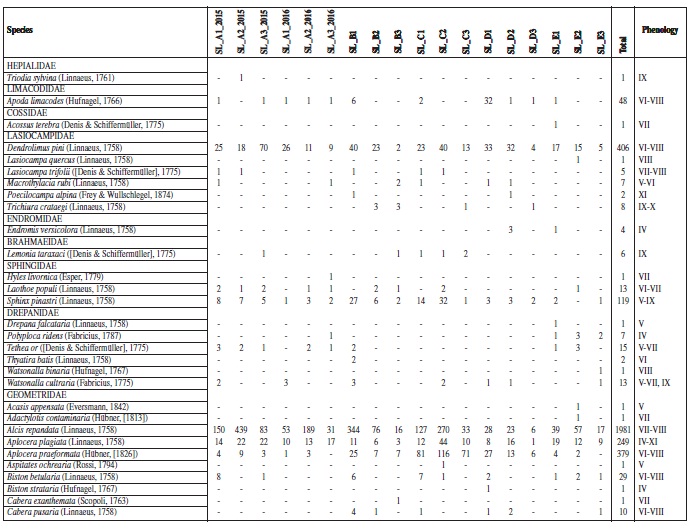
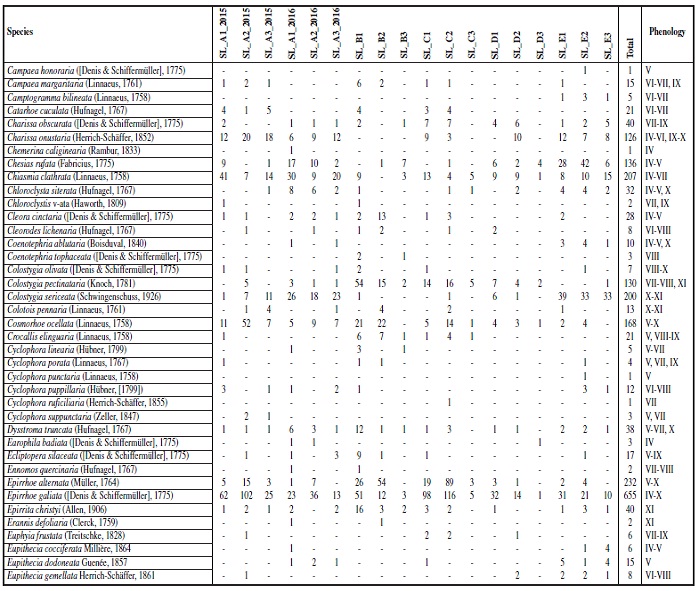
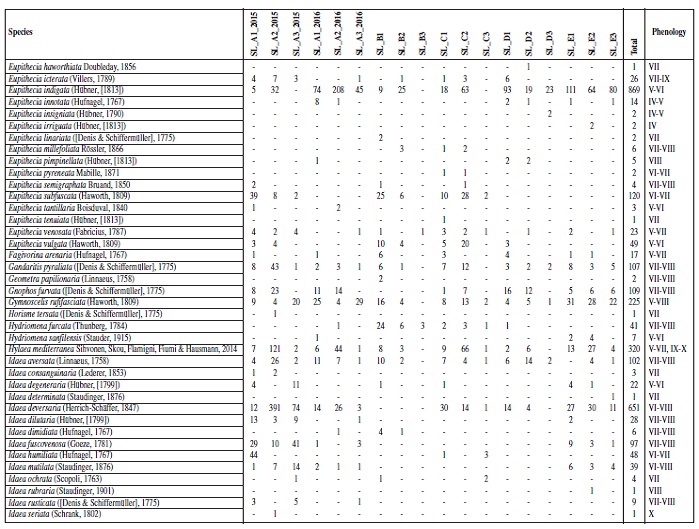
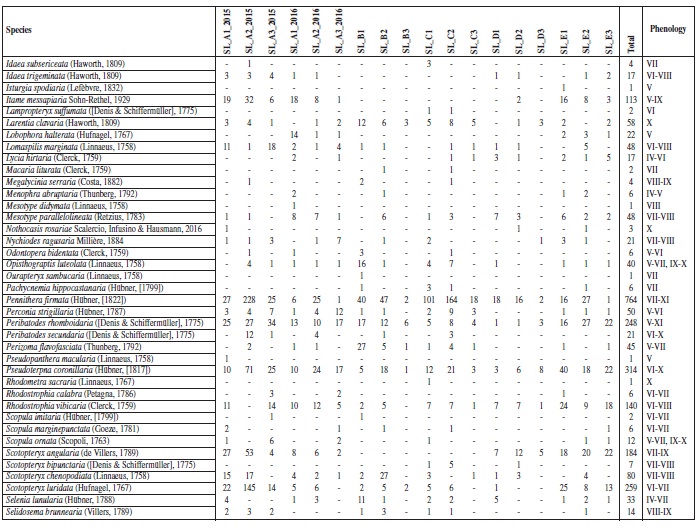
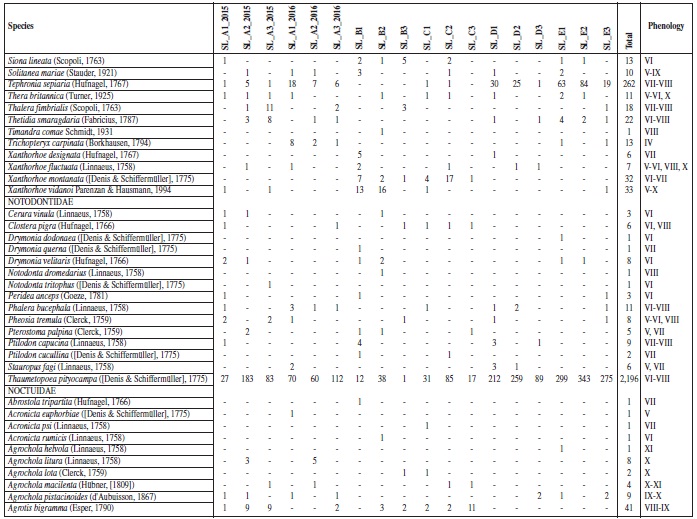
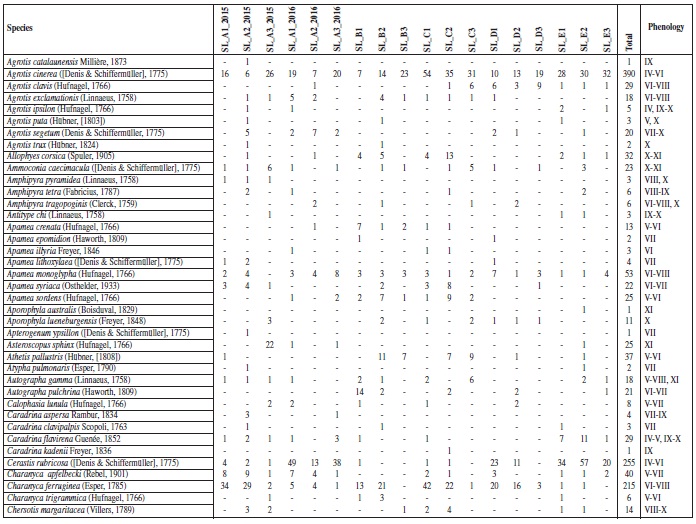
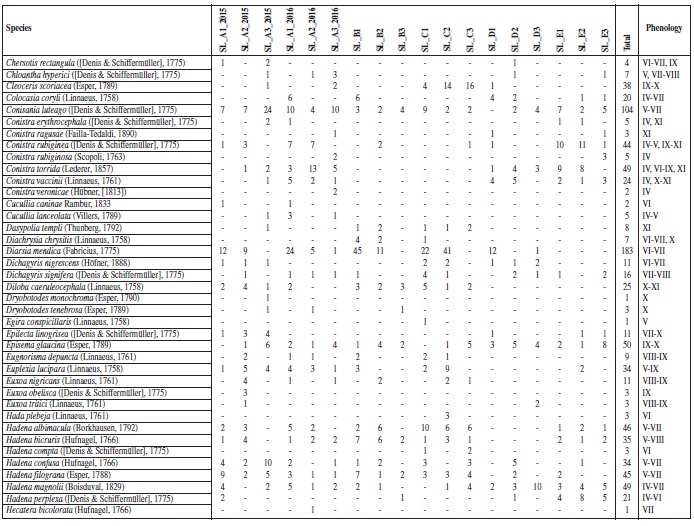
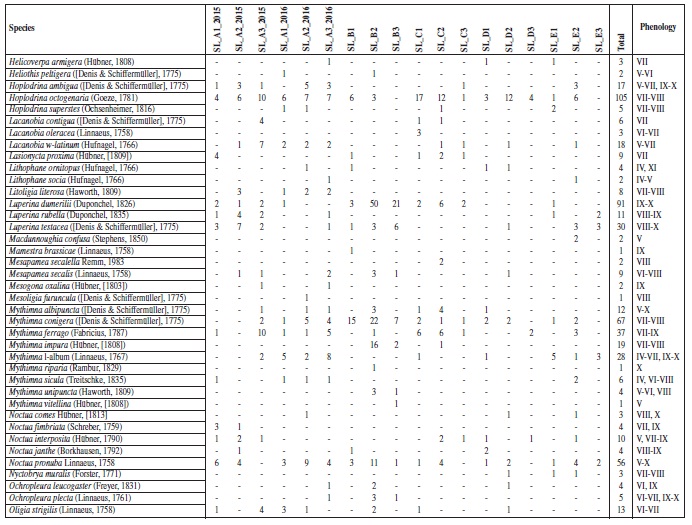
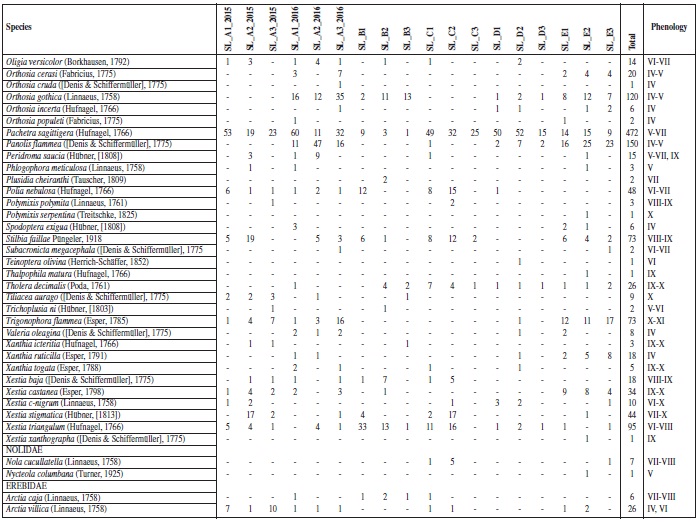
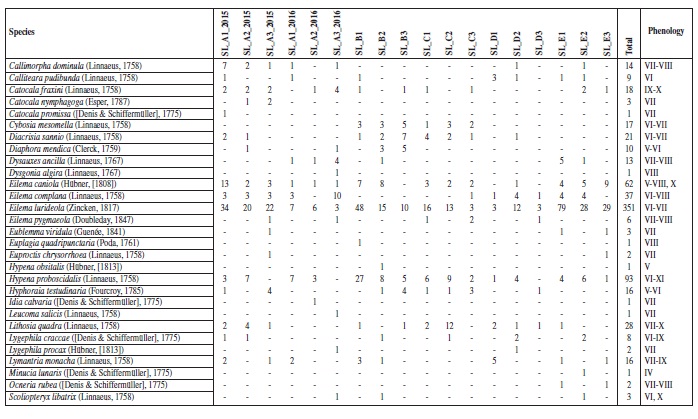
Author notes
*Autor para la correspondendcia / Corresponding author E-mail: stefano.scalercio@crea.gov.it